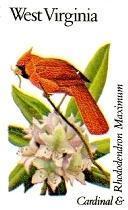
Cardinal
(Cardinalis cardinalis)
Adopted in 1949.
The Cardinal was made West Virginia's official bird by concurrent resolution of the 1949 Legislature. The male of the species is a rich scarlet with a mask and shading of black, while the young birds and females are a less brilliant color. The cardinal measures approximately eight inches long and is found from New York state to the Gulf of Mexico and as far west as Oklahoma. Its scientific name is Cardinalis cardinalis.
The northern cardinal is also the state bird for six other states. These are Illinois, Indiana, Kentucky, North Carolina, Ohio, and Virginia.
The Cardinal is sometimes called the Winter Redbird because it is most noticeable during the winter when it is the only "redbird" present. The Cardinal is one of the most common birds in our gardens, meadows, and woodlands. The male Cardinal is red all over, except for the area of its throat and the region around its bill which is black; it is about the size of a Catbird only with a longer tail. The head is conspicuously crested and the large stout bill is red. The female is much duller in color with the red confined mostly to the crest, wings, and tail. This difference in coloring is common among many birds. Since it is the female that sits on the nest, her coloring must blend more with her natural surroundings to protect her eggs and young from predators. There are no seasonal changes in her plumage.
The Cardinal is a fine singer, and what is unusual is that the female sings as beautifully as the male. The male generally monopolizes the art of song in the bird world.
The nest of the Cardinal is rather an untidy affair built of weed stems, grass and similar materials in low shrubs, small trees or bunches of briars, generally not over four feet above the ground. The usual number of eggs set is three in the South and four in the North. Possibly the Cardinal raises an extra brood down in the South to make up the difference, or possibly the population is more easily maintained here by the more moderate winters compared to the colder North.
The Cardinal is by nature a seed eater, but he does not dislike small fruits and insects.
|
|
| Kingdom |
Animalia -- animals |
| Phylum |
Chordata -- chordates |
| Subphylum |
Vertebrata -- vertebrates |
| Class |
Aves -- birds |
| Order |
Passeriformes -- perching birds |
| Family |
Fringillidae -- buntings, finches, grosbeaks, old world finches, sparrows |
| Genus |
Cardinalis Bonaparte, 1838 -- cardinals |
| Species |
Cardinalis cardinalis (Linnaeus, 1758) |